Exploring Endangered Fish Species and Conservation
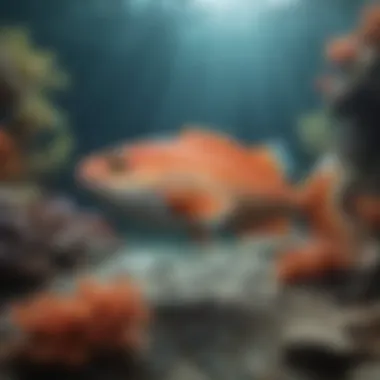

Intro
Endangered fish species represent a critical concern for global biodiversity. As aquatic ecosystems face unprecedented threats, understanding these species becomes essential for conservation efforts. The decline of fish populations signals broader ecological issues that affect not just marine life, but also human activities that depend on these vital resources.
With over 34% of fish species at risk of extinction, the urgency for action intensifies. This article examines these endangered fish species, elucidating the factors contributing to their fragile state and the ongoing efforts to protect them.
Overview of Research Topic
Brief Background and Context
Fish play a pivotal role in aquatic ecosystems. They contribute to nutrient cycling, maintain food webs, and offer economic benefits through fisheries and tourism. However, pollution, habitat destruction, overfishing, and climate change have severely impacted fish populations worldwide. It is crucial to reflect on these stressors that threaten their survival.
Importance in Current Scientific Landscape
The study of endangered fish species is significant for multiple reasons. Firstly, it provides insights into the health of aquatic environments. Secondly, understanding the dynamics of endangered species helps inform conservation strategies aimed at preserving biodiversity. Researchers and policymakers rely on data about these species to develop measures that foster ecosystem resilience and promote sustainable practices.
Methodology
Research Design and Approach
This comprehensive overview relies on a systematic approach to gather and analyze information about endangered fish species. The research synthesizes data from existing literature, conservation reports, and ecological assessments. It outlines the primary threats and highlights successful case studies where conservation efforts made a difference.
Data Collection Techniques
To ensure a broad understanding, diverse data collection techniques were employed:
- Review of Scientific Literature: Academic journals, articles, and books offered a foundational understanding of the issues at hand.
- Field Studies: Observations from various aquatic habitats provided practical insights into the health of fish populations.
- Interviews with Experts: Conversations with ecologists and conservationists enrich the analysis with firsthand knowledge and experiences.
This multifaceted methodology helps create a well-rounded picture of the state of endangered fish species and the ongoing efforts to secure their future.
Prelims to Endangered Fish Species
The plight of endangered fish species represents a significant environmental challenge that requires attention. With many fish populations declining due to various human activities, understanding this issue is crucial. The article aims to provide insights into what endangerment means for fish, and why these species are vital for aquatic ecosystems.
Defining Endangerment in Fish
Endangerment in fish refers to the state wherein a species faces a high risk of extinction. The categorization of endangerment is often derived from criteria set by organizations like the International Union for Conservation of Nature (IUCN). Some species fall into categories such as critically endangered, endangered, or vulnerable. Each designation reflects a species�’ reproductive success, population size, and habitat stability.
The understanding of these definitions is critical, as it informs conservation priorities and efforts. For example, critically endangered species may require immediate protection measures, unlike those that are merely classified as vulnerable. This clarity helps researchers and policymakers to prioritize resources effectively. In this context, recognizing the specific conditions resulting in endangerment allows for targeted solutions.
Importance of Fish in Ecosystems
Fish play an irreplaceable role in maintaining ecological balance. They contribute to nutrient cycling, serve as prey for numerous larger animals, and help control algal blooms by grazing. The loss of any fish species can disrupt these processes, leading to cascading effects on the ecosystem.
Consider the following key points outlining the importance of fish:
- Biodiversity: Fish species contribute to genetic diversity within their habitats. This diversity is crucial for resilience against diseases and environmental changes.
- Food webs: Fish are integral components of aquatic food webs. Their decline can affect not just their immediate predators, but the entire ecological community.
- Economic Value: Many communities depend on fish for their livelihoods, whether through commercial fishing or eco-tourism.
"Healthy fish populations are not just a matter of conservation, but a necessity for ecological integrity and human well-being."
In summary, endangered fish species are at the forefront of a complex web of ecological relationships. Their preservation is not merely a matter of conservation; it ensures that aquatic ecosystems continue to function effectively, benefiting all life forms reliant on these environments.
Criteria for Endangerment
Endangerment is a crucial topic when discussing the state of fish species worldwide. Understanding the criteria for endangerment helps in creating effective conservation strategies, as it delineates the parameters that assess the risks faced by various fish species. The criteria are not only a reflection of the species' current status but also indicators of the broader ecological health of aquatic environments.
IUCN Red List Categories
The International Union for Conservation of Nature (IUCN) offers a standardized method for assessing the conservation status of different species, including fish. The IUCN Red List categorizes species into various levels of risk based on their population size, distribution, and the degree of threat they face.
- Least Concern: Species that are widespread and abundant.
- Near Threatened: Species that are close to qualifying for a threatened category.
- Vulnerable: Species facing a high risk of extinction in the wild.
- Endangered: High risk of extinction in the wild.
- Critically Endangered: Extremely high risk of extinction in the wild.
- Extinct: No known individuals remaining.
- Extinct in the Wild: Species only known to survive in captivity.
Understanding these categories can assist researchers and policymakers in prioritizing conservation actions. Each level provides insight into the urgency and type of intervention required to protect the species.
Population Dynamics and Viability
Population dynamics refers to the changes in fish populations over time and the factors that influence these changes, including birth rates, death rates, immigration, and emigration. Viability, on the other hand, assesses whether a population can sustain itself over time without facing extinction.
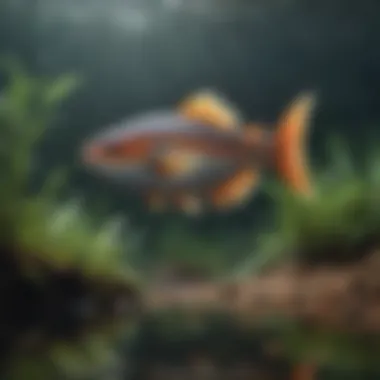

Several factors impact population dynamics:
- Reproductive Rates: High reproductive rates can buffer against population declines.
- Habitat Quality: Healthy habitats support higher population viability.
- Predation and Competition: Increases in predation or competition can lead to population reductions.
- Genetic Diversity: Populations with greater genetic diversity tend to be more resilient to environmental changes.
Analyzing these dynamics is essential for recognizing at-risk fish species. Effective conservation strategies require this understanding to ensure that fish populations remain viable and robust against external pressures. Without this knowledge, efforts to protect endangered fish could be misguided and ineffective.
Factors Contributing to Endangerment
Understanding the factors that contribute to the endangerment of fish species is crucial. These elements not only help us identify the species at risk but also guide our conservation strategies. By examining the causes, we can develop targeted interventions to mitigate the threats to these aquatic ecosystems.
Habitat Loss
Habitat loss is one of the most significant threats to fish species. Human activities such as urbanization, agriculture, and dam construction drastically change aquatic environments. Wetlands, rivers, and lakes are often drained or polluted, reducing the natural habitats available for fish to spawn and thrive. This leads to a decrease in population numbers as fish lose their breeding grounds.
Additionally, habitat fragmentation disrupts the migration patterns essential for various species. For example, salmon need to run upstream to spawn, but dams can block their path, leading to lower reproduction rates.
Overfishing and Unsustainable Practices
Overfishing is another pressing issue contributing to the endangerment of fish species. Unsustainable fishing practices not only reduce fish populations but also damage their habitats. Techniques like bottom trawling destroy the seafloor, affecting the entire marine ecosystem. Furthermore, bycatch, which refers to unintended catch during fishing, includes many endangered species. This can lead to a decline in already vulnerable populations, making recovery even more difficult. The Atlantic Bluefin Tuna, for instance, has faced severe population decreases due to overfishing driven by high demand in markets.
Pollution and Water Quality Issues
Water pollution poses a severe risk to fish populations. Runoff from agriculture often brings fertilizers and pesticides into waterways, leading to algal blooms that deplete oxygen levels. Fish struggle to survive in low-oxygen environments, leading to increased mortality rates. Heavy metals and plastics also contaminate fish, making them unsafe for consumption. The presence of pollutants can disrupt reproductive systems in fish, resulting in lower breeding success.
Maintaining water quality is essential for the survival of diverse fish species.
Climate Change Impacts
Climate change introduces additional stressors to aquatic ecosystems. Rising water temperatures affect fish metabolism and reproduction. Many species are sensitive to changes in temperature and may not survive in warmer waters. Moreover, altered precipitation patterns lead to changes in water levels, impacting habitats further.
Coral reef fish are particularly vulnerable as rising sea temperatures cause coral bleaching, resulting in loss of habitat. Alongside this, ocean acidification, stemming from increased carbon dioxide levels, threatens marine life by weakening the structures of species reliant on calcium carbonate. It is essential to understand these dynamics to effectively address the impacts of climate change on fish populations.
"The decline of fish species impacts not only biodiversity but also the livelihoods of communities relying on fishing, making this issue of urgent concern."
As we delve deeper into these factors, it becomes clear that concerted conservation efforts are necessary to tackle each of these threats. The future of many fish species hinges on our ability to implement sustainable practices, improve water quality, and mitigate climate change.
List of Notable Endangered Fish Species
Endangered fish species play a critical role in maintaining the health and balance of aquatic ecosystems. This section will explore various notable fish that are facing the threat of extinction. By understanding the characteristics and importance of these species, we can better appreciate their contribution to biodiversity and the overall well-being of the environment. The decline of any fish species signifies a larger issue regarding water quality, habitat loss, and human impacts.
Freshwater Fish at Risk
Sturgeon Species
Sturgeon species are ancient fish that have existed for over 200 million years. They are particularly noteworthy for their long lifespan and unique reproductive habits. Sturgeons are vital to aquatic ecosystems as they contribute to nutrient cycling through their foraging behaviors. Their high demand for caviar from their eggs makes them popular, which is ironically a primary reason for their endangerment. The unique feature of their ability to inhabit both freshwater and saltwater adds to their ecological importance, yet it also exposes them to varied human impacts.
Darwin’s Cichlid
Darwin's Cichlid, native to Lake Victoria, stands out not only for its distinct coloration but also for its complex behavioral traits. This species is essential in understanding the dynamics of speciation and evolution in isolated environments. Cichlids exhibit various feeding strategies, which highlight their role in maintaining ecosystem balance. However, they are threatened by habitat degradation and invasive species. Their adaptability in different environments showcases both advantages and disadvantages; while it increases their resilience, it also leads to competition with non-native species.
Marine Fish Facing Extinction
Atlantic Bluefin Tuna
The Atlantic Bluefin Tuna is known for its size and speed, making it one of the largest tuna species. This fish is critical for the commercial fishing industry and has great cultural significance in cuisine, particularly in sushi. Their pelagic lifestyle allows them to traverse vast ocean spaces, which makes conservation efforts complicated. Unfortunately, overfishing severely threatens their populations, reflecting the larger issues of sustainable fishing practices. Their rapid decline serves as a warning sign for marine health, emphasizing the need for stricter regulations.
Napoleon Wrasse
The Napoleon Wrasse is easily identifiable with its large, elongated body and prominent forehead bump. This species is not only stunning but also vital to the reef ecosystem. They help control populations of important marine organisms, affecting overall reef health. The Napoleon Wrasse is a strong indicator of ocean health, as their presence shows a balanced ecosystem. Despite its ecological importance, it faces significant threats from illegal fishing and habitat destruction. Its status highlights the urgent need for habitat protection and sustainable fishing practices.
Endangered Fish in Coral Reefs
Clownfish Species
Clownfish are famous for their vibrant colors and symbiotic relationship with sea anemones. This relationship helps protect them from predators while providing the anemone with nutrients. As a popular species in aquariums, clownfish have a significant presence in culture and education. However, their natural habitats are under severe threat from coral reef degradation and climate change. Ultimately, the decline of clownfish represents wider ecological issues impacting coral reefs.
Humphead Wrasse
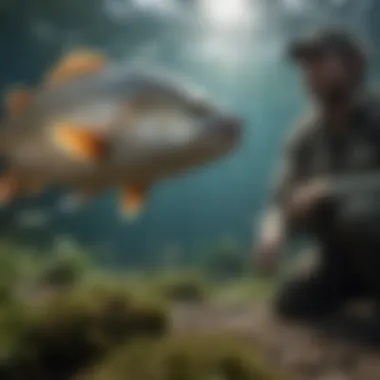
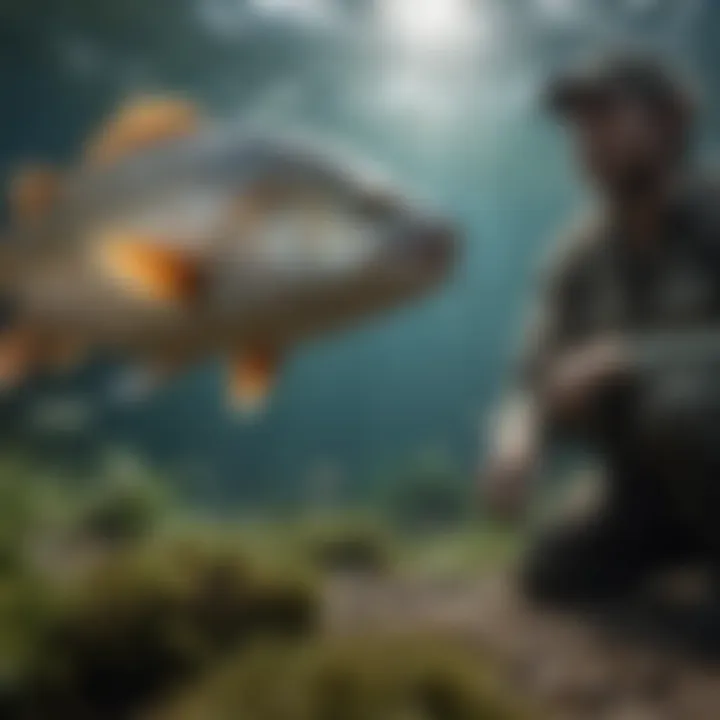
The Humphead Wrasse is notable for its size and distinctive coloration. This large fish plays a crucial role in coral reef ecosystems, as it preys on coral-dwelling organisms and contributes to reef health. Their long lifespan allows them to develop complex behaviors and social structures. The Humphead Wrasse faces significant challenges from overfishing and habitat degradation, making its conservation critical for the well-being of reef ecosystems. The continued survival of this species serves as an essential indicator for the health of coral habitats.
Conservation Efforts
Conservation efforts represent a critical response to the ongoing decline of fish populations worldwide. These initiatives aim to restore fish habitats, enforce protection laws, and promote sustainable fishing practices. By addressing the various threats that these species face, effective conservation strategies can significantly slow down or even reverse the trends of endangerment. Moreover, these efforts contribute to the overall health of aquatic ecosystems, which are vital for human life and biodiversity.
Legislation and Policies
CITES and its Role
The Convention on International Trade in Endangered Species of Wild Fauna and Flora (CITES) plays a pivotal role in regulating the trade of endangered fish species. Its primary goal is to ensure that international trade does not threaten the survival of these species in the wild. One key characteristic of CITES is its list of species protected under different levels of biological risk, which can impact trade regulations significantly. CITES is beneficial because it raises awareness on a global scale and fosters cooperation among countries.
However, CITES faces challenges. The enforcement of its regulations can be inconsistent across different nations. Some countries might lack the resources or commitment to implement CITES recommendations effectively.
Nations' Regulatory Frameworks
Each nation is responsible for creating its own regulatory frameworks to protect endangered fish species. These frameworks are often based on the guidelines set by international agreements like CITES. The key characteristic of such frameworks is their local nature, allowing for adaptation to specific environmental and cultural contexts. This is beneficial as it can lead to more effective conservation strategies that reflect local needs and circumstances.
Nevertheless, the unique feature of nations' regulatory frameworks can also be a disadvantage. Variability in commitment and standard practices can lead to gaps in protection that endangered species need. If regulations are not harmonized or enforced equally, the overall effectiveness in conserving these fish can be diminished.
Research and Monitoring
Population Surveys
Population surveys are essential for understanding the status of endangered fish species. They provide necessary data on the number and health of fish populations. By identifying trends over time, researchers can evaluate the effectiveness of conservation efforts. The key characteristic of these surveys is their scientific basis, which enables accurate assessments and informed decision-making. This makes them a beneficial tool in formulating strategies for conservation.
That said, population surveys can be resource-intensive and time-consuming. In some cases, they may not cover all areas where endangered species are found, potentially overlooking critical habitats.
Habitat Restoration Projects
Habitat restoration projects are crucial for the recovery of degraded ecosystems that support endangered fish species. These projects aim to restore natural environments to create suitable habitats. The key characteristic of such projects is their focus on long-term ecosystem health rather than short-term fixes. This approach is beneficial as it ensures that the restored habitats can sustain fish populations over time.
However, restoration projects can face obstacles, such as funding shortages and lack of community interest. These challenges can affect the project's success and the recovery of the species that rely on these habitats.
Community Involvement
Local Fisheries Management
Local fisheries management is an important aspect of conservation efforts as it targets sustainable fishing practices that directly impact fish populations. It encourages communities to play an active role in managing resources. The key feature of such management is its localized approach, which empowers communities to enforce regulations that consider their specific cultural and economic contexts. This involvement is beneficial as it can lead to more effective and accepted conservation policies.
On the downside, without proper training and resources, local fisheries management may lack the scientific foundation needed for effective decision-making, which could hinder conservation efforts.
Educational Programs
Educational programs are vital for raising awareness about endangered fish species and the importance of conservation. These programs educate various stakeholders, including fishermen and students, about sustainable practices that can protect fish populations. The key characteristic of educational programs is that they foster community engagement and promote informed public participation. They are beneficial because they cultivate a sense of responsibility and advocacy for aquatic ecosystems among individuals.
Yet, the reach and impact of educational programs can vary widely. If they do not resonate with local communities or lack adequate resources, their effectiveness can be limited. This could result in a disconnect between education and community action, ultimately affecting conservation goals.
Conservation efforts for endangered fish species require a multi-faceted approach that involves legislation, community participation, and ongoing research. Only through collaborative and cohesive strategies can we hope to secure a future for these species.
The Role of Aquariums and Zoos
Aquariums and zoos have a significant role in the conservation of endangered fish species. These institutions are not merely places to display aquatic life; they contribute to preservation and education. Their functions span across different areas such as public engagement, species recovery, and fostering community understanding about biodiversity.
Captive Breeding Programs
Captive breeding programs are essential for the survival of many endangered fish species. These programs aim to reproduce fish in controlled environments before releasing them back into their natural habitats. They help in maintaining genetic diversity, which is crucial for resilience against diseases and adapting to environmental changes.
An example of this is the California Condor program, which has seen participation from both aquariums and zoos to develop techniques to breed critically endangered species.
Breeding in captivity offers a controlled setting where researchers address factors that hinder reproduction in the wild. By using methods like artificial insemination and ensuring optimal living conditions, institutions can improve the chances of survival for at-risk species.
However, successful captive breeding requires careful monitoring. Not all fish thrive in captivity, and some may lose their ability to survive once released. Therefore, it is crucial to balance breeding with habitat restoration efforts.
Public Awareness and Education
Public awareness and education are vital components of the mission of aquariums and zoos. They serve as platforms to educate the public, fostering understanding of the challenges endangered fish face. Through exhibits, interactive displays, and informational sessions, these institutions connect people to the aquatic world.
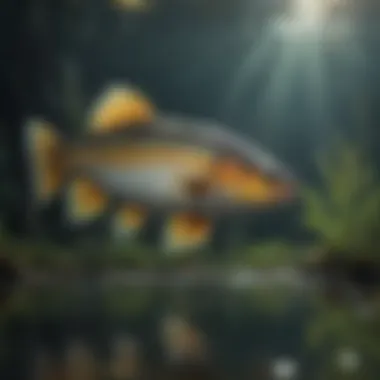

Educational programs increasingly incorporate technology and hands-on experiences. These initiatives engage audiences and create lasting impressions about environmental stewardship.
For example, visitor interactions can lead to greater public support for conservation policies. Informed visitors may contribute to local conservation efforts and advocate for sustainable practices in fishing and water use. Moreover, the opportunity to observe endangered species helps to create empathy and motivate action.
"The key to conservation is educating the next generation. Understanding leads to action."
In summary, aquariums and zoos not only play an educational role but also engage in active conservation efforts. The combination of captive breeding programs and public education creates a foundation for preserving endangered fish species in the wild.
Ecological Impact of Endangered Fish Species Decline
The decline of endangered fish species presents several concerns for ecosystems that rely on their presence. Fish are integral to aquatic habitats, influencing both the environment and the other organisms that share it. Their roles can vary widely, from being predators to prey, contributing to nutrient cycling, and maintaining the health of their ecosystems. Understanding the ecological impact of their decline is crucial for recognizing the broader consequences for biodiversity and ecosystem functionality.
Ecosystem Balance Disruption
When fish species start to decline, the balance of the ecosystem begins to change. Fish occupy various levels in the food chain, and their absence can lead to overpopulation of certain species. For example, if a predator fish becomes endangered, the prey population can increase unchecked. This can lead to overgrazing of plants or the overconsumption of smaller fish, which might themselves be important for the health of the ecosystem. The disruption can cause cascading effects, where other species are forced to adapt, relocate, or face extinction as well. The following points clarify this issue further:
- Loss of Biodiversity: Fish populations often support a variety of species. When one species is lost, it can cause a reduction in the genetic variation of the ecosystem.
- Altered Nutrient Cycling: Many fish contribute to nutrient recycling in the water. A decline can affect the nutrient levels, potentially leading to algal blooms and oxygen depletion.
Ecosystem balance is delicate. Each fish species plays a part, and their decline signals problems that are often indicative of broader environmental issues.
Effects on Food Webs
Food webs are intricate networks that illustrate how species interact within an ecosystem. The loss of endangered fish species can lead to significant disruptions in these webs. Fish not only serve as food for larger predators but also control the populations of their prey.
When certain fish species decline, the implications include:
- Predator-Prey Relationships: The disappearance of specific fish can destabilize predator-prey dynamics, leading to increased mortality for some species while others flourish.
- Energy Transfer: Every species plays a role in energy transfer within an ecosystem. The decline of a fish species can hinder this transfer, reducing available energy for higher trophic levels.
- Impact on Human Fishing Practices: A decline in natural fish populations can lead to overreliance on alternative sources, which may also have negative impacts on ecosystems.
"The health of aquatic ecosystems hinges on the diversity of fish species, reflecting the stability and resilience of the environment."
Future Directions in Conservation Research
Research on endangered fish species is increasingly essential as the challenges faced by aquatic ecosystems become more complex. Addressing these challenges requires innovative approaches and a clear understanding of global dynamics affecting marine and freshwater environments. Continued exploration of conservation techniques not only enhances the preservation of fish species but also contributes to broader environmental health. This section examines upcoming methodologies and collaboration efforts that are pivotal for future conservation endeavors.
Innovative Strategies
Innovative strategies in conservation research focus on leveraging technology and modern science to address threats facing endangered fish. One notable advancement is the use of genomics. Genetic tools can identify species at risk and assess their genetic diversity. This information assists in planning breeding programs and reintroduction initiatives.
Remote sensing technologies are also gaining traction. These tools can monitor water quality and habitat changes on a large scale. For example, satellite imagery can reveal alterations in coastal ecosystems, thus allowing researchers to assess the impact of human activities and climate change.
Further, environmental DNA (eDNA)* analysis emerges as a revolutionary technique. By collecting water samples, researchers can detect the presence of fish species without visual confirmation. This method is effective in surveying species presence in difficult-to-reach habitats.
The integration of community science initiatives engages local citizens in data collection. This approach fosters a sense of ownership and raises awareness about local aquatic biodiversity.
"Innovative conservation practices utilize technology to expansion efforts, tracking and managing risks effectively."
Global Cooperation and Policies
Global cooperation forms the backbone of effective conservation policies. Various international agreements, like the Convention on Biological Diversity and commitments under the Paris Agreement, emphasize the need for collective action. Enhanced dialogues among nations about marine and freshwater ecosystems are critical in the fight against fish endangerment.
Policies focusing on sustainable fishing practices also require cross-border collaboration. Fish species do not adhere to human-made boundaries, highlighting the need for a comprehensive approach that includes regional fishing agreements.
Investment in education and awareness programs across nations increases public involvement in conservation efforts. Governments and conservation organizations need to unite to form policies that facilitate habitat protection, regulate fishing, and promote sustainable practices. These engagements require ongoing monitoring and flexibility to adapt to changing environmental conditions.
End
In this section, we will explore the significance of understanding and conserving endangered fish species. The decline of these species highlights a critical imbalance in aquatic ecosystems and their complex interdependencies. As crucial components of the biosphere, fish directly influence the health of water bodies, impacting both biodiversity and the evolutionary trajectory of other aquatic organisms. This article emphasizes the urgent need for sustainable practices and a collaborative approach to mitigate threats.
Summary of Key Points
The examination of endangered fish species reveals several pivotal aspects:
- Habitat Degradation: Biodiversity faces threats from human activity, causing loss of essential fish habitats.
- Overfishing: Unsustainable fishing practices lead to rapid declines in fish populations.
- Pollution: Contaminated waters pose severe risks for aquatic life.
- Climate Change: Temperature alterations and ocean acidification affect fish survival and reproduction.
Collectively, these factors contribute to the decline of species such as the Atlantic Bluefin Tuna and Darwin’s Cichlid, emphasizing the necessity for proactive conservation measures.
Call to Action for Conservation Efforts
A multifaceted response is essential to combat the endangerment of fish species. Key actions include:
- Support Sustainable Fisheries: Choosing responsibly sourced seafood can help sustain fish populations.
- Advocate for Policy Change: Engage in civic actions that promote stronger environmental protections
- Participate in Research Initiatives: Contributing to data collection and analysis can enhance our understanding of fish populations.
- Educate Communities: Raising awareness about the importance of fish conservation can mobilize localized efforts.
Conservation efforts rely on both individual and collective action. By addressing these issues through activism and sustainable practices, we can help protect fish species that are vital to our environmental health.
Encouraging collaborative initiatives between governments, organizations, and communities is fundamental for effective change in conservation strategies. The future of fish species rests in our hands, urging each of us to take responsibility for the waters we share.



